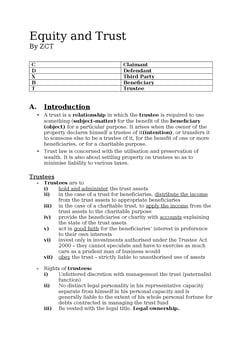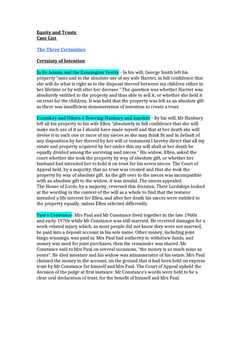Foskett v McKeown [2001] 1 AC 102 esp
Judgement for the case Foskett v McKeown
Table Of Contents
KEY POINTS
Tracing and following: Tracing and following are both involved in determining what happened to the plaintiffs' money. Both are exercises in locating assets that are or may be taken to represent an asset owned by the plaintiffs and over which they claim ownership.
However, the techniques used in following and tracing are distinct. Following refers to the process of chasing after the same asset from hand to hand. Tracing is the process of locating a new asset that replaced the old one. When one asset is exchanged for another, a claimant has the option of following the original asset into the hands of the new owner or tracing its value into the new asset in the same owner's hands.
Tracing or following are not a claim or remedy, it is merely a way to identify the property that needs to be claimed.
While, the remedy in case of misappropriated funds would be to either demand a proportionate share of the asset or enforcing a lien on it in order to obtain a personal claim against the trustee for the amount of the misappropriated funds.
FACTS
Mr. Murphy, in breach of trust, stole £20,440 from a company he owned and controlled. The company had received investments from around 200 individuals, including the claimant , Mr. Foskett, in order to purchase land in Algarve, Portugal. The land had been purchased, yet, it was never developed as planned.
Mr. Murphy used the trust funds to settle his life insurance policy's fourth and fifth installments. He had previously used his own funds to cover the first two or three premiums. Soon after paying off the installments, Mr. Murphy committed suicide.
In lieu of the life insurance, the remaining beneficiaries of the policy received a payment of £1,000,000. Mrs. Murphy received one-tenth of the share.
The dispute lies between Mr. Murphy's three children (who are beneficiaries under the policy trust) and the buyers of the Portuguese plots, from whose funds £20,440 was used to pay the fourth and fifth premiums in breach of the investors’ trust deed.
The investors including Mr. Foskett, claimed that at least 40% of the policy's premiums were paid with their money, and that as their funds were traced through the policy and into the policy moneys, they were entitled to 40% of the policy money. On the other hand, the children ( beneficiaries of the policy) contended that the purchasers were only entitled to the recovery of the money that was misappropriated to pay the premiums, or £20,440 plus interest.
As the misappropriated funds had been used to acquire the insurance policy, the claimants (investors) claimed that they had proprietary interest in the insurance handout. The beneficiaries, however, argued that only an equitable lien should be able to the claimants, and should only receive the amount that was taken to pay off the insurance premiums.
COMMENTARY
The judgement, delivered by Lord Millett, ruled that this was a question of vindication of property rights rather than unjust enrichment.
The Court of Appeal ruled that the purchasers did not have a right to a pro rata share of the policy proceeds but were entitled to repayment of the fourth and fifth premium amounts plus interest. Therefore, the claimants could get an equitable lien over the proceeds of the policy to secure the misappropriated funds plus interest.
The Court also ruled that money should be divided between the parties based on the proportions in which they invested to the premiums.
ORIGINAL ANALYSIS
McKeown misappropriated money entrusted to him for the purchase of land in Portugal. He used part of the money to pay two of the premiums on his life assurance policy. Prior to the payment being made he divested the beneficial interest in the policy to his three children. McKeown committed suicide.
The claimant, one of the prospective purchasers (i.e. beneficiary), claimed to be entitled to the proceeds of the policy.
The HL held that the purchasers’ claim was an assertion of an equitable proprietary interest arising out of the mixing of the premiums with the value of the policy. As such the purchasers were entitled to a pro rata share of the monies from the policy.
Lord Millett
He defined both ‘following’ and ‘tracing’.
Following is the process of following the same asset from hand to hand whereas tracing is identifying a new asset as the substitute for the old. When one asset is exchanged for another, can follow it into the hands of the new owner or trace its value to the new asset. Will depend on the circumstances.
Tracing is not a remedy/claim: It is simply an identification of the property to be claimed.
I would state the basic rule as follows: where a trustee wrongfully uses trust money to provide part of the costs of acquiring an asset, the beneficiary is entitled at his option either to claim a proportionate share of the asset or to enforce a lien upon it to secure his personal claim against the trustee for the amount of the misapplied money.
It does not matter whether the trustee mixed the trust money with his own in a single fund before using it to acquire the asset, or made separate payments (whether simultaneously or sequentially) out of the differently owned funds to acquire a single asset.
-
i.e. the beneficiaries could choose between either:
A constructive trust over the proceeds for the proportion of the life insurance payout purchased with their money; or
An equitable lien over the fund for the repayment of that amount.
-
The basis of this CT is to vindicate the plaintiffs' original proprietary rights.
This is problematic: The ‘rights’ needing vindication are to a share of the original trust money - what they are in fact getting is a new right to a share in the life insurance policy which, since they are getting a proportion-as opposed to the value to which they were entitled under the original trust-could greatly exceed the value of the initial right.
Perhaps unjust enrichment would therefore make more sense.
The only defence to an equitable proprietary claim is bona fide purchase of a legal estate for value without notice, from which it must obviously follow that change of position is not a defence to such a claim, i.e. goes against the ‘unjust enrichment’ rationale.
The minority in the House of Lords argued that the claimants should only recover the premium because it could not be shown that the stolen moneys were used to acquire the death policy or the death benefit and the claimants accordingly had no proprietary interest in the proceeds of the policy.
For Further Study on Foskett v McKeown

Equity notes fully updated for recent exams at Oxford and Cambridge. Th...
Need instant answers? Our AI exam tutor is here to help.
Ask questions 🙋 Get answers 📔 It's simple 👁️👄👁️
Our AI is educated by the highest scoring students across all subjects and schools. Join hundreds of your peers today.
Get StartedSimilar Cases
Related Product Samples
These product samples contain the same concepts we cover in this case.

 Since 2010, Oxbridge Notes has been a trusted education marketplace, supplying high-quality materials from top achievers at universities like Oxford, Cambridge, LSE, Harvard, and Yale.
Since 2010, Oxbridge Notes has been a trusted education marketplace, supplying high-quality materials from top achievers at universities like Oxford, Cambridge, LSE, Harvard, and Yale.